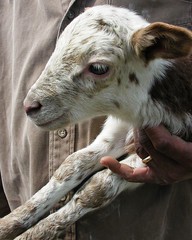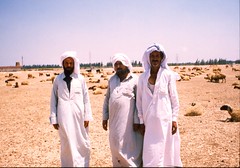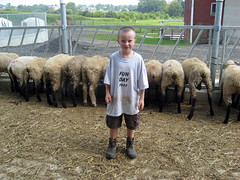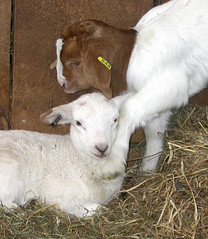|

Holding a lamb

Spring lambs

Bedouin shepherds

Green pastures

Young boy with sheep

Kazakh shepherds

Lamb and goat
|
The Lord is my Shepherd
Sheep are mentioned in the Bible more than 500 times, more than
any other animal. The prominence of sheep in the Bible grows out
of two realities. Sheep were important to the nomads and agricultural
life of the Hebrews and similiar peoples. Secondly, sheep are
used throughout the Bible to symbolically refer to God's people.
Biblical shepherds
Now Abel kept flocks, and Cain worked the soil. In the course
of time Cain brought some of the fruits of the soil as an offering
to the Lord. But Abel also brought an offering -- fat portions
from some of the firstborn of his flock. (Genesis 4:3-4)
The very first shepherd was Abel. He was also humanity's first
murder victim, slain by his brother Cain. Abraham and Moses were
shepherds. King David was the best known shepherd of Bible history.
He wrote the beloved Psalm 23. Shepherds were the first people
to see the newborn Jesus Christ. The Prophet Mohammed worked as
a shepherd when he was 8 years old.
A close relationship
My sheep listen to my voice; I know them, and they follow me.
(John 10:27)
The Bible describes close relationships between shepherds and
their flocks. The sheep recognize the voice of the shepherd. They
follow him (or her). The shepherd protects his flock and would
give his life for them.
It is known that animals can instantly recognize the voice of
a familiar trusted person. Sheep have excellent memories for faces.
They remember their handler. They also remember people who inflict
abuse upon them.
Break a leg?
There is a commonly-held belief that shepherds in Biblical times
would break the legs of lambs that constantly wandered away. According
to the "story," the shepherd would then set the broken
leg and carry the lamb on his shoulders until the leg healed,
after which time the lamb would remain by the shepherd's side
for the rest of its life. While there is no way to know for certain what Biblical shepherds did, there is no such story in the Bible, and to do so would be cruel and impractical.
The Lamb of God
Christians traditionally refer to Jesus as the "Lamb of God."
Many Christians serve lamb as part of their Easter dinner. In
many homes, a lamb-shaped cake decorates the table. Many Eastern
Orthdox Christians hang pictures of the Easter lamb in their homes.
Sacrificial lamb
Abraham looked up and there in a thicket he saw a ram caught
by its horns. He went over and took the ram and sacrificed it
as a burnt offering instead of his son. (Genesis 22:1-18)
Abraham's sacrifice
It is well-known to Muslims, Jews, and Christians that Abraham
was asked to sacrifice his son. He was willing to do so, but God
gave him a sheep (ram) to sacrifice instead of his son Christians and
Jews believe that the life of Isaac was saved, while Muslims believe
that it was Ismael that was nearly sacrificed on the alter. Jews
and Arabs trace their heritage to Isaac and Ismael, respectively.
Festival of Sacrifice
In commemoration of Abraham's willingness to sacrifice his son
as an act of obedience to God, a religious festival is celebrated
by Muslims worldwide. The festival is called Eid al-Adha. Its
English translation is "Festival of Sacrifice." Eid is the arabic word for Festival. As a
symbol of Abraham's sacrifice, Muslims (who are able) sacrifice
a sheep (or other domestic animal). The sheep have to meet certain
age requirements (at least one year of age) and quality standards
(unblemished). The meat is shared with family and friends and
distributed to the poor.
Aqeeqah (aqiqah)
The Muslim "equivalent" to Christian Baptism is aqeeqah,
which occurs 7 days after the birth of a child. Aqeeqah includes
shaving the baby's head and naming the baby. As a symbol of thanksgiving
for the gift of a child from God, a sacrifice is performed. Two
sheep which resemble each other, are to be sacrificed for a boy
and one for a girl. The meat is shared with family, friends, and
the poor.
Spotted sheep
So that very day, Laban went out and formed a flock for Jacob.
He took from his herds all the male goats that were ringed and
spotted. He also included the females that were speckled and spotted
with any white patches, and all of the black sheep. (Genesis
30:35)
Jacob sheep were named for
the Biblical story of Jacob who selected spotted sheep for his
flock. It tells how Jacob took every speckled and spotted sheep
as his own from Laban's flock. Some claim that Jacobs of today
descend directly from the sheep raised by Jacob, that traveled
from Palestine to Egypt and to Spain via the coast of North Africa
and Morocco.
Separating the sheep from the goats
He shall set the sheep on His right hand, but the goats on
the left. (Matthew 25:33)
With regards to "judgement day," sheep and goats are
used as metaphors in the Bible. Sheep are the followers of Christ,
while goats chose not to follow Christ. The parable is based on
the differences in behavior between sheep and goats. Sheep are
gentle, quiet, innocent animals. They do not give their shepherds
a lot of problems. They are easily led. Sheep are grazers, unlike
the goat, which likes to browse. Goats are rebellious. In the
Bible, goats are sometimes used to symbolize evil.
<== HISTORY AND OTHER INTERESTING
STUFF
|







